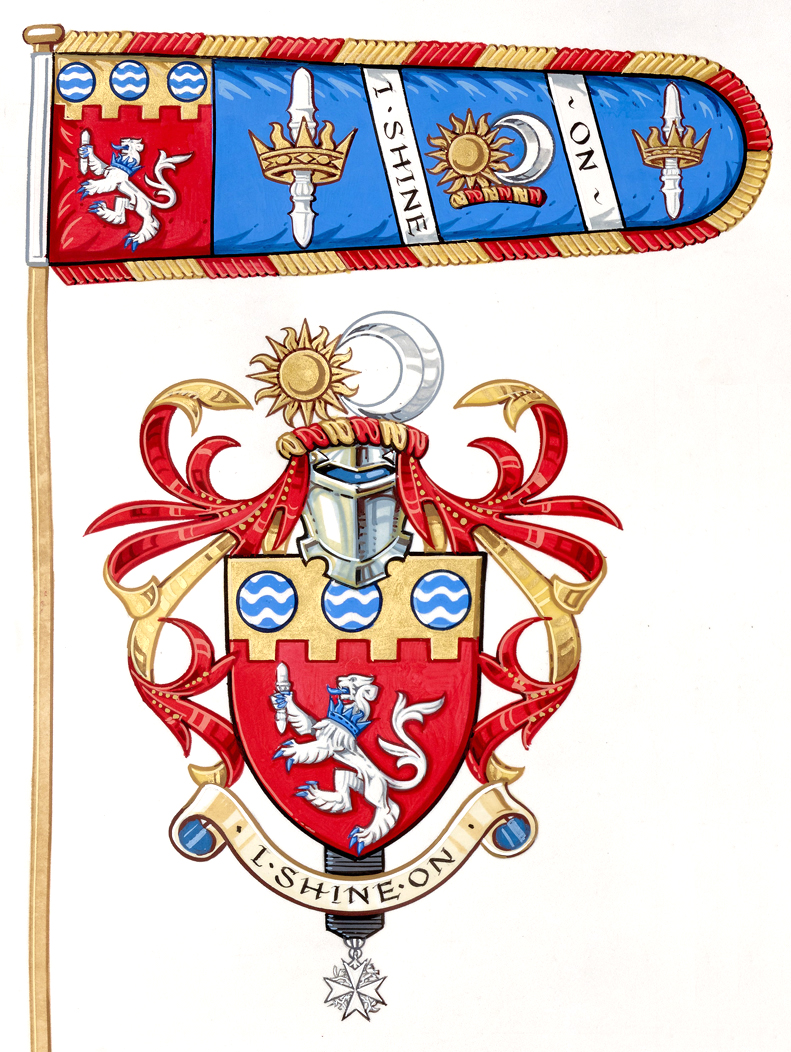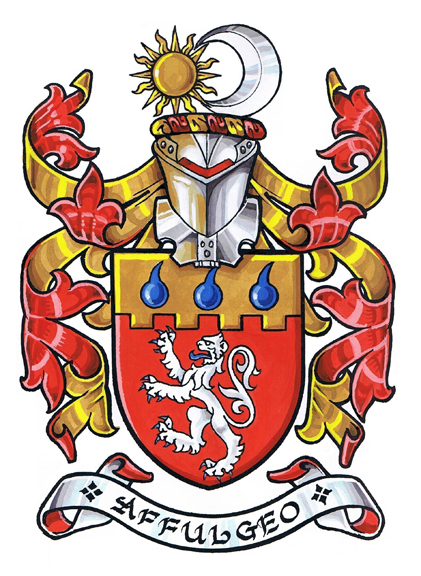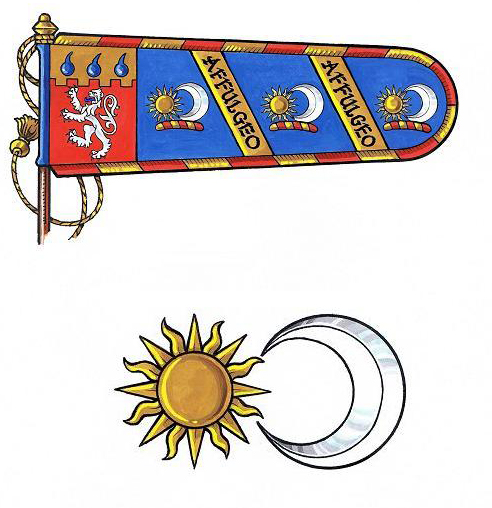
Edward Thiravej Ploysongsang (朱生勝), Esq.
Thailand and United States

2017 Arms and Standard, granted by the College of Arms
Artist: Robert John Parsons, MBE
 |
 |
2002 Arms |
2002 Arms with supporters. |
 |
 |
first standard and badge |
second standard and badge |
Artists: Gordon Macpherson for arms and first badge and standard;
Gordon Macpherson and David Wooten for second badge and standard;
Michael Waas for arms with supporters.
Registered in The Chinese Armorial, November 1, 2011 and December 16, 2017.
Arms (2017): Gules a Lion rampant Argent gorged with a Crown radiant Azure holding in the dexter forepaw a single pointed Vajra palewise Argent on a Chief embattled Or three Fountains.
Arms (2002): Gules a lion rampant Argent on a chief embattled Or three gouttes de larmes.
Crest: Upon a helm wreathed and mantled Gules doubled Or dexter the sun in splendour Or and adjacent to it an increscent moon Argent (2017 College of Arms blazon: Upon a Helm with a Wreath Or and Gules A Sun in splendour Or on the dexter abutting the points of an Increscent Argent on the sinister Mantled Gules lined Or)
Supporters: dexter a Brahma bull Argent armed sable and sinister a Bengal tiger Proper.
Motto (2017): I SHINE ON
Motto (2002): Affulgeo (I Shine On).
Badge #1: Dexter the sun in splendor Or and adjacent to it an increscent moon Argent.
Badge #2: A single-pronged vajra Argent enfiling a crown rayonné Or (2017 College of Arms blazon: A single pointed Vajra palewise Argent enfiling a Crown radiant Or)
Standard #1: In the hoist the arms; in the fly, Azure, between two transverse bands Or, each bearing the motto Affulgeo, three representations of the crest; the whole fringed compony Or and Gules, the sleeve Azure.
Standard #2: In the hoist the arms; in the fly, Azure, charged with the crest between two representations of the badge (#2) all separated by transverse bands Or, each bearing the motto Affulgeo; the whole fringed compony Or and Gules, the sleeve Azure.
Standard #3 (2017): In the hoist the arms; in the fly, Azure, charged with the crest between two representations of the badge (#2) all separated by transverse bands Or bearing the motto I SHINE ON written as I SHINE on the dexter band an ON on the sinister band; the whole fringed compony Or and Gules, the sleeve Azure.
Grant: 2017 Arms: College of Arms, October 13, 2017.
Registration: 2002 Arms: South African Bureau of Heraldry: arms (registration certificate 3299), badge #1 (registration certificate 3300), and standard #1 (registration certificate 3301), November 29, 2002.
Royal Certification: The arms, crest, motto, badge #2 and standard #2 were certified by Don Fernando Muñoz Altea, the King of Arms of the Royal House of Bourbon-Two Sicilies in 2008.
Some Private Registrations:
Russian College of Heraldry (Collegium Heraldicum Russiae), February 19, 2003. 2002 Arms.
American College of Heraldry, The Armorial Register of America, certificate number 2315, March 22, 2003. 2002 Arms, badge #1, and standard #1.
Heraldische Gemeinschaft Westfalen (Westphalia Heraldry Society), registration no. DEV204, December 10, 2004. 2002 Arms and supporters.
International Register of Arms, Registration No. 0394 (Vol. 3), August 11, 2016. 2002 Arms, supporters, and standard #2.
International Register of Arms, Registration No. 0442 (Vol. 3), December 28, 2017. 2017 Arms, badge, and standard #3.
Committee on Heraldry of the New England Historic Genealogical Society, March 11, 2019, 2017 Arms.
Background and History:
The armiger registered a coat of arms, badge, and standard at the Bureau of Heraldry, South Africa, in 2002. In 2017, the College of Arms granted a similar but different coat of arms and a standard to him.
The armiger currently works as a legal consultant in Thailand. He founded Ployprathip International Law Office (PILO), a full-service international law firm in 2007 after several years at other international firms in Bangkok.
He has a Bachelor's degree from the University of Wisconsin-Madison, a Master of Regional Planning degree from Cornell University, a Juris Doctorate from Washington University in St. Louis, and an Executive Master of Business Administration degree from the Sasin Graduate Institute of Business Administration of Chulalongkorn University in Thailand. In addition, he has an EMBA certificate from the Kellogg School of Management of Northwestern University. The armiger is also licensed to practice law in New York State and before the U.S. Supreme Court along with several other U.S. federal courts.
His peers elected him a Fellow of the Royal Asiatic Society of Great Britain and Ireland and a Member of the Chartered Institute of Arbitrators (U.K.).
The colour red symbolizes Mr. Ploysongsang's Chinese surname, Zhu (朱), which means vermillion or bright red. His paternal grandfather was a Chinese who settled in Thailand and adopted the Thai surname Ploysongsang. Bright red is also one of the school colours of Cornell University, where the armiger studied city and regional planning.
The colour yellow or gold symbolizes Mr. Ploysongsang's legendary ancestor, the Yellow Emperor or Huangdi (黃帝, reigned 2697 BC – 2597 BC). According to Zhu clan legend, the progenitor of the surname was a Chinese knight named Cao Xie (曹侠), who in turn was allegedly an agnatic descendant of the Yellow Emperor through his grandson Emperor Zhuanxu (顓頊, reigned 2514 BC – 2436 BC). King Wu (reigned 1046 BC – 1043 BC) of the Zhou Dynasty (reigned 1046 BC – 256 BC) appointed Cao Xie as the ruler of the small feudal state Zhu (邾國), which was located just southeast of Qufu City in Shandong Province. Zhu (邾國) means the “Red State”. His family ruled the state, later moving it further south and renaming it Zou State (鄒國) until it was conquered by the much larger kingdom of Chu (楚國) around 350 B.C. Cao Xie’s many descendants took refuge mostly in neighbouring Jiangsu, Anhui and Henan Provinces, but they adopted the Zhu (朱), Zhu (邾) and Zou (鄒) surnames, among others, in remembrance of their former state.
The shield is divided into a chief and a base. The chief, which is the most honoured part of a shield, is gold to honour the clan’s descent from the Yellow Emperor. The embattled red base reflects the Zhu surname, its feudal origins, and Mr. Ploysongsang’s studies in city planning.
On the 2002 arms, the three drops of water and crest symbolize a late-19th century paternal ancestor, who held the genealogical designation Paiming (派明), which literally means “a Descendant or Representative of the Ming (Dynasty)”. The armiger's Chinese surname is the same surname as that of the Ming Emperors of China. Family members long believed that they were direct descendants of the Ming Emperors (reigned AD 1368–1644). The Pai (派) portion of this designation consists of three smaller strokes on the far left of the character (氵), symbolizing three drops of water. The drops of water are placed in the chief, the most honoured part of the shield, thereby alluding to the importance of the Paiming designation.
On the 2017 arms, the armiger changed the 3 drops of water to 3 fountains because he had learned that his family descends directly from Zhu Xi and can claim distant genealogical connections with Confucius and Yan Hui. These three persons are major saints of Confucianism, a philosophical system represented by the Chinese character for water. The fountains retain the water imagery of the 2002 arms and also represent knowledge in Western symbolism, i.e., the fountain of knowledge.
The Ming (明) portion of Paiming's designation consists of the character Ri (日), which means the sun, and the character Yue (月), which means the moon. Because the sun and moon are celestial bodies, the armiger incorporated them in his crest since it is the ‘highest’ part of his coat of arms.
Recent genealogical research, however, reveals that Mr. Ploysongsang's family is actually descended from the famous Song Dynasty philosopher and synthesizer of Neo-Confucianism, Zhu Xi (朱熹), Duke of Hui State (徽國公, b. 1130 – d. 1200 AD), who in turn was a distant cousin several times removed from the Ming Emperors. When he designed his coat of arms, however, Mr. Ploysongsang only knew of his 19th century ancestor and the ancient origins of his clan. Therefore, he used his recent ancestor’s designation for his design.
The lion alludes to the armiger on four levels. First, in India and Thailand, the lion is called a "singh", so the beast represents both a pun on his surname and an allusion to the Thai and Indian portions of his heritage. Second, the lion as the king of the beasts refers to his undergraduate studies in zoology and his interest in the natural world. Third, the lion alludes to the armiger's profession as an attorney since lions are seen as protectors of the law in many Asian countries. Fourth, the lion is silver to symbolize light and alludes to the Ploysongsang surname, which means "radiant jewel".
The coat of arms combines the national colours of the United States and Thailand (red, white, blue) with the traditional colours of China (red and gold) and the historic Zhu State (red).
The Latin motto for “I Shine On”, and again alludes to his surname. On the 2017 College of Arms grant, the motto is in English.
The second badge also refers to the Ploysongsang surname. In Indic mythology, which greatly influenced Thai culture, the vajra or thunderbolt is also described as a jewel. Together, the crown radiant and the vajra jewel symbolize the surname, which as stated earlier means "radiant jewel". These same elements are in the arms as well to better tie the badge to the arms, though now with the crown symbolizing authority and the vajra representing action.